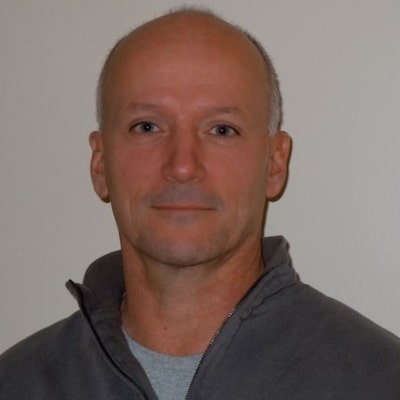
Paul F. James
Biographical Information
Paul James is a molecular physiologist who uses a synthesis of molecular biology, cell biology, biochemistry, and physiology to understand the specific in vivo functional roles of individual protein isoforms that transport ions across biological membranes. Specifically, he is interested in using rats and mice (knockout and transgenic) as models to define the roles that isoforms of the Na,K-ATPase and the sodium hydrogen exchanger (NHE) play in male reproductive physiology.
The Na,K-ATPase transports sodium ions (Na+) out of the cell and potassium ions (K+) into the cell utilizing energy released during ATP hydrolysis thereby establishing electrochemical gradients across the cell membrane. The NHEs maintain intracellular pH by transporting hydrogen ions (H+) out of the cell using the energy stored in the Na+ gradient established by the Na,K-ATPase. Sperm contain two of the four known Na,K-ATPase alpha isoforms and up to six of the thirteen identified NHE isoforms, four of which (alpha4 Na,K-ATPase, NHA1/NHEDC1, NHA2/NHEDC2, and NHE10) have been shown to play important roles in sperm motility and fertility. The role that the other Na,K-ATPase and NHE isoforms play in sperm physiology is currently unresolved. The focus in the James laboratory is directed towards 1) defining the distinct roles that individual Na,K-ATPase alpha and NHE isoforms play in regulating different aspects of sperm physiology (motility, capacitation, the acrosome reaction, etc.), 2) determining the specific functional interactions between these isoforms in sperm that allow regulation of intracellular pH, 3) identifying the cellular mechanisms that regulate the activity of these transporters in sperm, 4) investigating the role that the Na,K-ATPase and NHE isoforms play in human reproduction and reproductive dysfunction, and 5) examining the role that epigenetic mechanisms play in regulating the expression of the sperm-specific Na,K, ATPase and NHE isoform genes.
In addition to his work on the physiology of membrane transport proteins found in sperm, Dr. James is also collaborating in the design and testing of novel osteogenic scaffold compositions/architectures for use in bone tissue engineering. In the US alone, a cost of more than $5 billion/year is estimated for the more than 1 million surgical procedures involving the partial excision of bone, bone grafting and fracture repair, a substantial percentage of which is for the elderly. The ability of these scaffolds to support osteogenesis in vivo will be an important step towards using these scaffolds to support the growing need for alternatives for bone grafting.
Education
- Ph.D., Biophysics, Boston University School of Medicine (1996)
Selected Publications
- Kumar, D.L., Kumar, P.L., James, P.F. (2016) Methylation-dependent and independent regulatory regions in the Na,K-ATPase alpha4 (Atp1a4) gene that may impact its testis-specific expression. Gene. 575(2 Pt 1):339-52. doi: 10.1016/j.gene.2015.09.003.
- Yousefi A.M., James P.F., Akbarzadeh R., Subramanian A., Flavin C., Oudadesse H. (2016). Prospect of Stem Cells in Bone Tissue Engineering: A Review. Stem Cells Int. 2016:6180487. doi: 10.1155/2016/6180487.
- Kumar P.L., James P.F. (2015) Identification and characterization of methylation-dependent/independent DNA regulatory elements in the human SLC9B1 gene. Gene. 561(2):235-48. doi: 10.1016/j.gene.2015.02.050.
- Akbarzadeh, R., Minton, J., Janney, C.S., Smith, T.A., James, P.F., Yousefi, A. (2015) Hierarchical polymeric scaffolds support the growth of MC3T3-E1 cells. J Material Science: Materials in Medicine, 26(116):1-12. doi: 10.1007/s10856-015-5453-z.
- Minton, J., Janney, C., Akbarzadeh, R., Focke, C., Subramanian, A., Smith, T., McKinney, J., Liu, J., Schmitz, J., James, P.F., and Yousefi, A.M. (2014) Solvent-free polymer/ceramic scaffolds for bone tissue engineering: fabrication, analysis, and cell growth, J Biomat Sci: Polym Ed, (16):1856-74. doi: 10.1080/09205063.2014.953016.
- Hlivko, J.T., Chakraborty, S., Hlivko, T.J., Sengupta, A., James, P.F. (2006) The human Na,K-ATPase alpha4 isoform is a ouabain-sensitive alpha isoform that is expressed in sperm. Mol Repro and Dev, 73(1):101-115. doi: 10.1002/mrd.20383.
Courses Taught
- BIO 103: Introduction to Research in Biology
- BIO 161: Principles of Human Physiology
- BIO 203: Introduction to Cell Biology
- BIO 471/571: Molecular Physiology
- BIO 605: Advanced Molecular Biology
- BIO 710: Advanced Seminar in Biology: Mechanisms of Migraines
- BIO 710: Advanced Seminar in Biology: RNAi in Animals
- BIO 710: Advanced Seminar in Biology: Epigenetics